This post may contain affiliate links. Please read our disclosure policy.
This vegan blue cheese is simply mind-blowing! Naturally cultured and prepared with just 5 ingredients, it makes use of traditional cheese-making techniques. The result is a sharp, creamy, and rich vegan blue cheese like you have never tried before!

IT IS HERE. The vegan blue cheese recipe is finally here, guys!
I’m really, really excited about this recipe. First, because I have been working on it for several months, and second, because it tastes exactly like blue cheese.
⭐️ Why You Should Try This Recipe
- The texture is just perfect. It’s creamy so you can spread it easily on a slice of bread, but firm enough to cut it into slices. Plus, it has those natural blue veins that are so characteristic of blue cheese.
- It has that rich and strong aroma. This cheese is actually even stronger in taste than my vegan aged camembert! Non-vegans could not believe it was not “real” blue cheese!
- It’s a fun experiment. Whether you are new to vegan cheese making or made some before, the process of making this blue cheese is interesting and exciting at the same time. You will see the mold slowly grow over a few weeks!
- It’s a reader’s favorite. With 244 ★★★★★ ratings, this recipe is a must-try! James said “Just tasted my first batch of this. It is quite simply, the best vegan cheese I have ever made. All thanks to you Thomas – another epic recipe.”
🧀 What is Blue Cheese
Blue cheese is a type of semi-soft cheese that is made with Penicillium roqueforti cultures. This edible mold not only creates a sharp and piquant flavor, but it is also responsible for the blue/green veins inside and outside the cheese.
Historians say that Gorgonzola is one of the oldest types of blue cheese, appearing around AD 879.
🥛 Ingredient Notes
Just like my vegan aged camembert, this blue cheese is made with just 5 ingredients. Here is what you will need:
- Cashews – The base of this cheese is raw cashews. They bring the perfect amount of creaminess and richness. Do not use roasted cashews.
- Probiotics – To give the blue cheese its tangy flavor, we will be using probiotics that will trigger the fermentation process. I recommend using either Acidophilus or Mesophilic. The latter is specifically made for cheese making and yields a superior flavor.
- Mold culture – Penicillium roqueforti is the mold that will give the cheese its rich flavor and blue color.
- Coconut oil – The coconut oil is here to add creaminess, it also helps the mold grow since it requires a lot of fat. I recommend refined coconut oil, that has been deodorized.
- Salt – Salt not only enhances the flavor but also prevents bad mold from growing.
About the Penicillium roqueforti: You can get the penicillium roqueforti mold here. It might seem a little bit expensive but a little goes a long way. For 4 pieces of cheese, you will only need 1/8 tsp. It can be stored in the freezer for months.
🥣 How to Make Vegan Blue Cheese
The recipe is actually pretty easy to make; the hardest part is to be patient since the whole process will take over a month.
Prepare the cashew cream
Start by soaking the cashews in water for at least 5 hours or overnight. Then, blend them with water and coconut oil until it forms a smooth cream. Next, add the probiotics and penicillium roqueforti and blend again.
Transfer the cashew cream to a bowl and cover it with plastic film to touch. It needs to ferment at room temperature for one day to kick off the fermentation process.
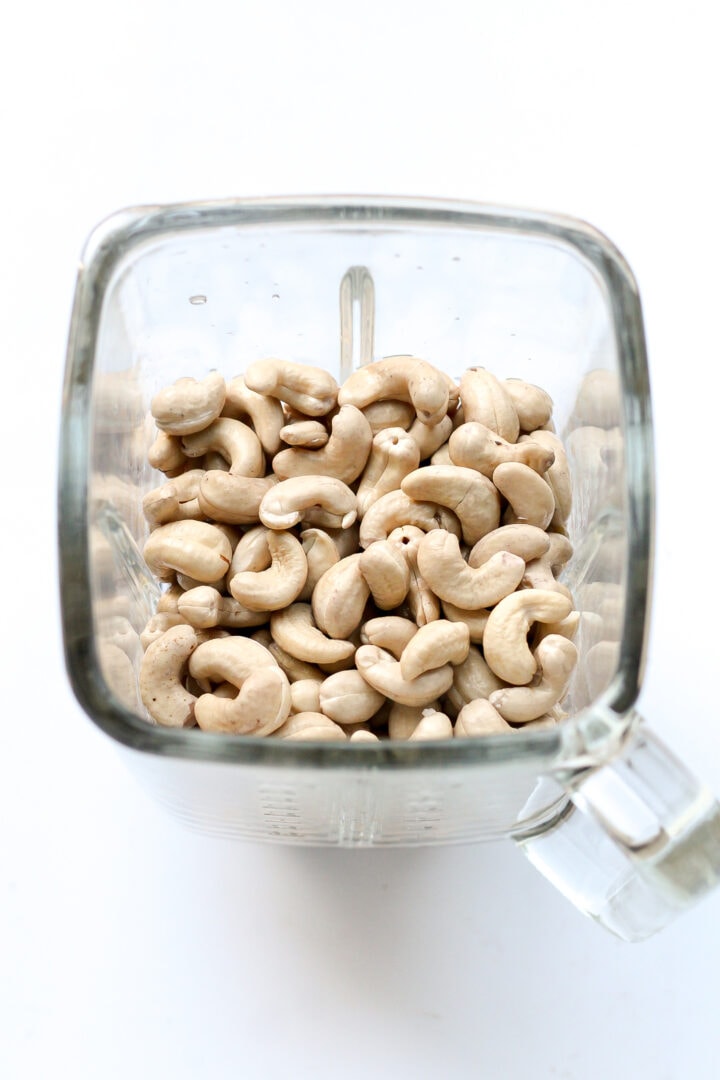
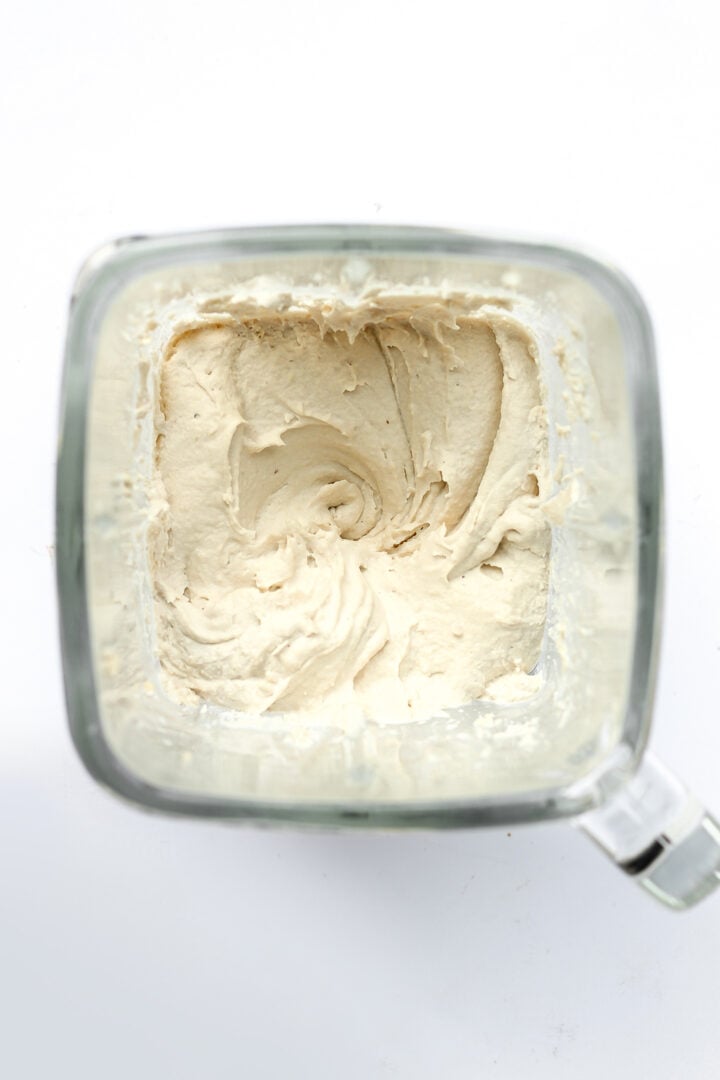
Shape the cheeses
Next, it’s time to shape the cheeses. Line springform pans or cookie cutters with parchment paper and fill each one with cashew cream. Note: the size or shape of your pans doesn’t matter too much, so use what you have on hand.
Place the cheeses (still in the pans) in a container and refrigerate overnight.
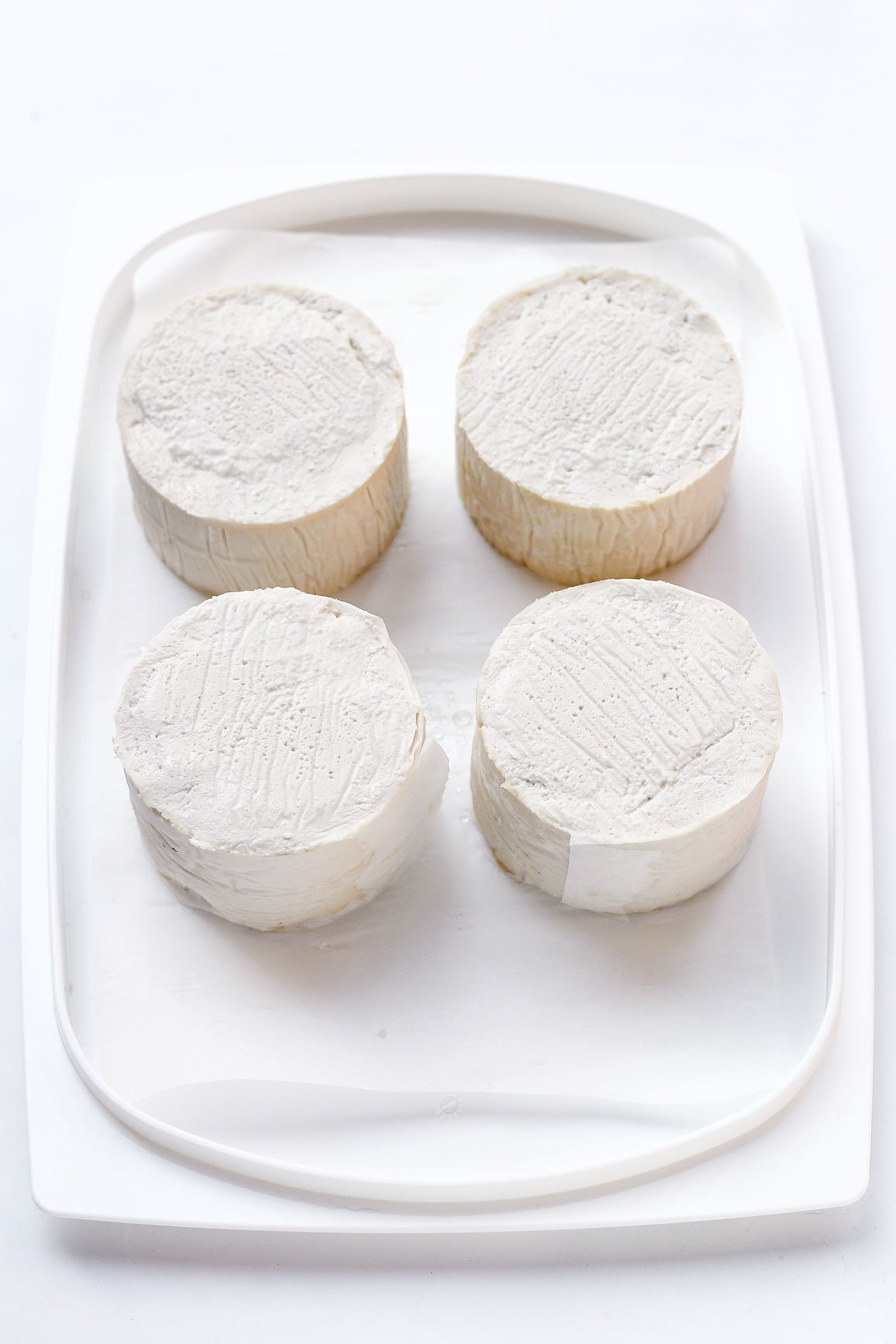
Salt the cheeses
The next day, it’s time to remove the cheeses from the pans and salt them. Salt will help with mold growth, so it’s essential. To do so, sprinkle sea salt on the top and sides of each cheese and use your finger to rub the salt. Very carefully flip the cheeses and sprinkle salt on the opposite side.
Place the cheeses on parchment paper and put them back in the container.
Age the cheeses
It’s not time to age the cheeses and let the mold grow! Age the cheeses in your refrigerator at a temperature of about 47-52°F (8-11°C) and flip them every day.
After 7 days, you should start to see some light blue/green mold spots; it’s a good sign! Continue the process for another 7 days.
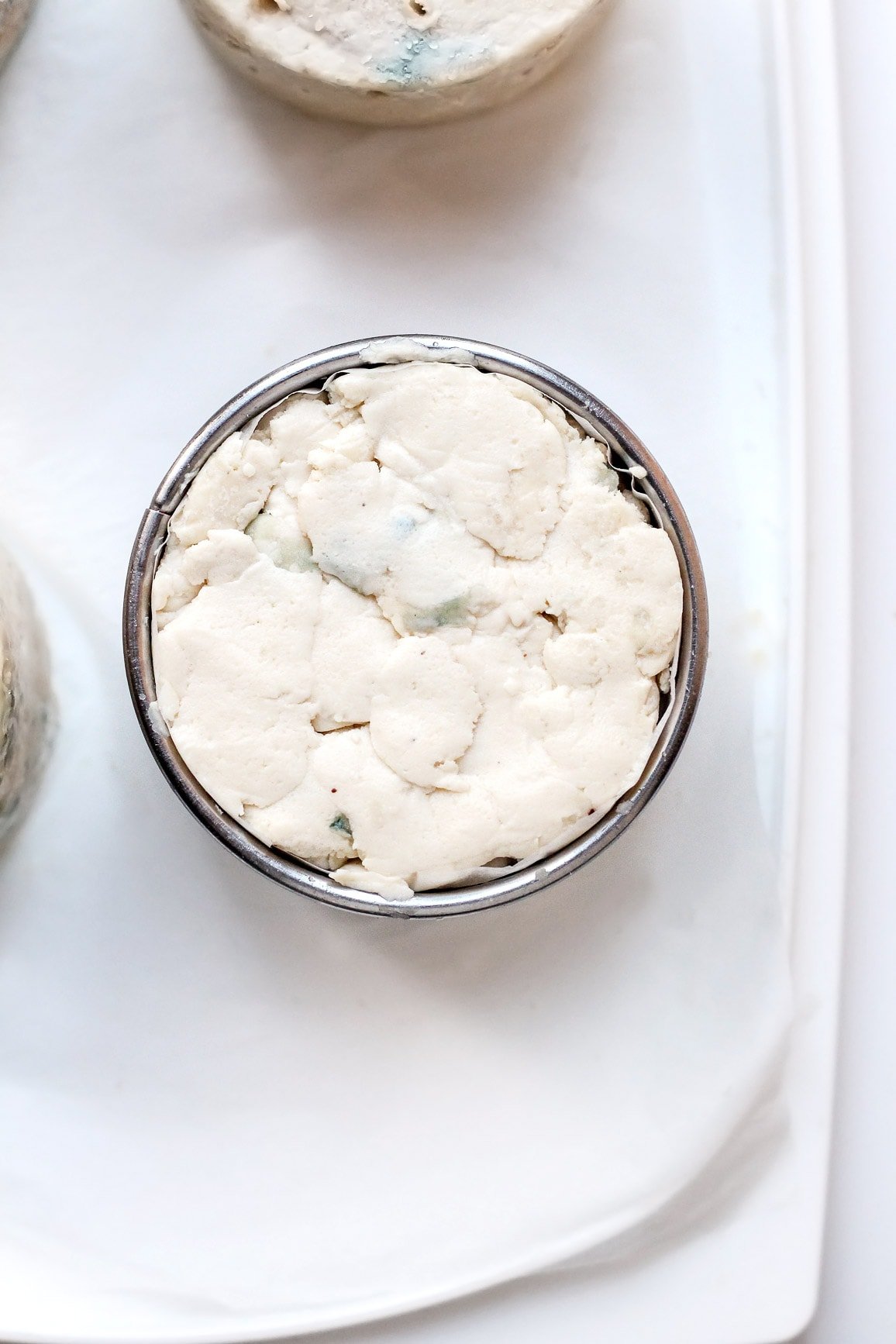
Crumble and re-shape
After a total of 14 days, your cheeses should be a bit firmer and almost completely covered with blue mold. It’s now time to crumble them.
Why crumble the cheeses?
It’s the blue mold that gives the cheese its characteristic flavor. The problem is that the mold needs to be in contact with the air to grow, so you need to have many small openings inside the cheese for better mold growth. Regular blue cheeses are often pierced several times with a skewer to make holes. I tried this way but with no success. After several tries, I thought of scrambling the cheese into little pieces and then forming it again without pressing too much to leave large holes inside it. It worked!
Using clean hands, scramble the cheese in a large bowl (just like you would scramble tofu). Next, line springform pans or cookie cutters with parchment paper and re-fill them with the cashew cream without pressing too much to leave large holes on the inside.
The final step is to keep flipping the cheeses every day and wait…Your cheeses will be ready in 3 more weeks, but if you are patient enough to wait for an extra 2 weeks I promise you won’t regret it! It will become even stronger and sharper.
Serve this blue cheese alongside vegan camembert, onion chutney, and grapes and you have one of the best vegan cheese platter!
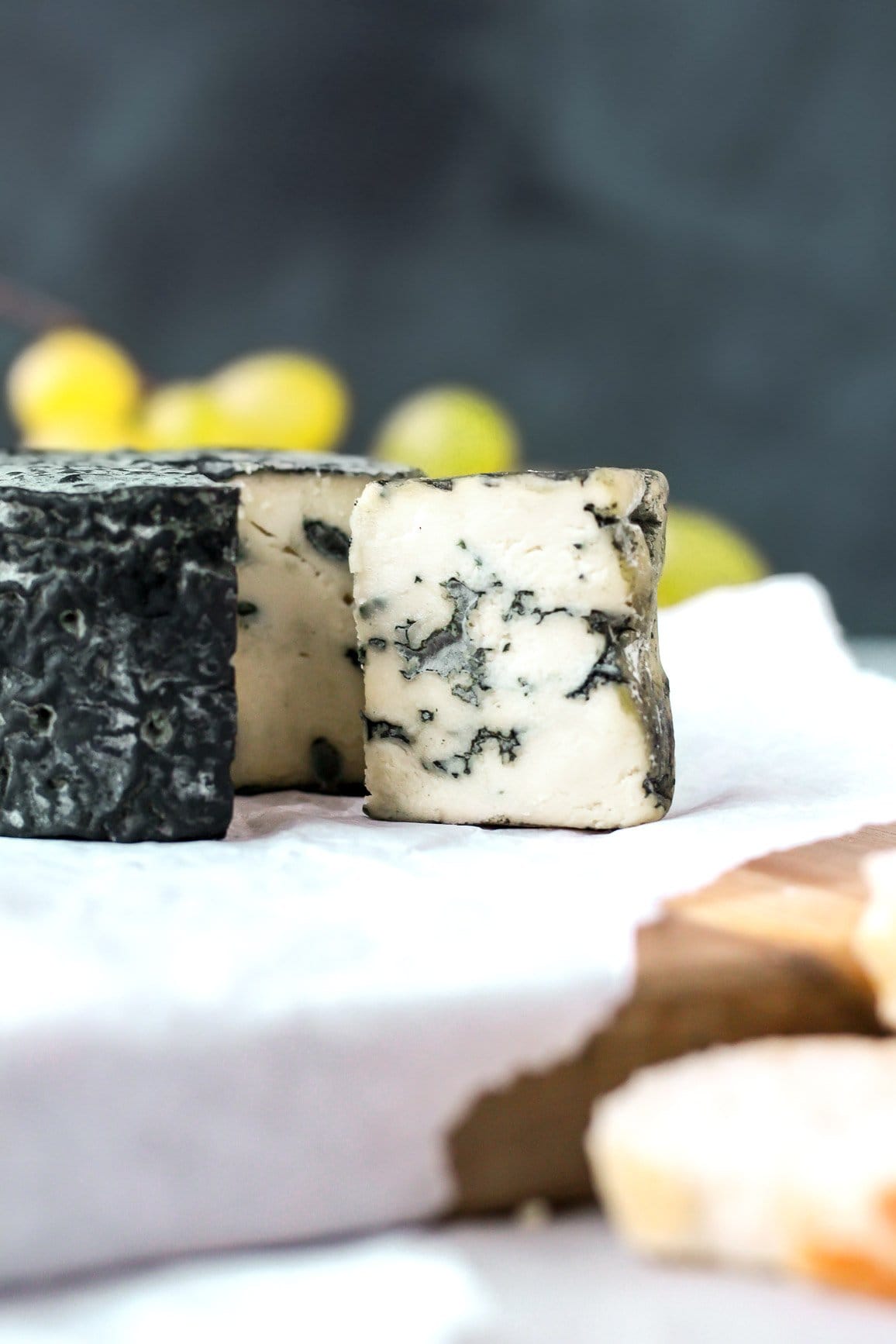
📔 Tips
- Age the cheeses in a container during the complete aging process. Mold needs humidity to grow. That’s why you need to keep the cheeses in a small box or container in your refrigerator. If you were to let the cheeses uncovered, they would dry out before the mold gets a chance to grow.
- Do not omit any ingredient. This recipe is not versatile, so I do not recommend substituting or omitting any ingredient.
- Use latex gloves. By using gloves each time you handle the cheeses, you reduce your chances of seeing bad mold growing. Latex gloves are pretty cheap and come in large boxes, so do not hesitate to get yourself a box.
- If you are making vegan camembert at the same time: I recommend you keep them in two separate boxes. Mold can transfer very easily, and you could end up with white mold on your blue cheese or blue mold on your camembert.
- Regarding the appearance of the cheese. The rind of this blue cheese is dark blue because I didn’t scrape the sides. Be aware the rind is edible, but if you prefer the exterior to be white, you can gently scrape the mold using a clean knife every two weeks. I prefer to leave the rind because it looks cooler, and after about a month, it will become a little bit firmer. Creamy inside + firm rind = perfect cheese to me.
💬 FAQ
Yes, blue cheese contains a natural mold that is called Penicillium. This type of mold gives the cheese its flavor and color.
Blue cheese has a sharp and tangy taste with subtle piquant/spicy notes.
As long as it’s good mold, yes!
It’s very easy to tell if a cheese has gone bad; just smell it. If it has a rotten eggs smell, you should trash it. If there is some pink or black fuzzy mold, it’s not good either.
Roquefort is a type of blue cheese that is only produced in a specific area of France. It is a protected designation of origin.
No, this vegan blue cheese does not melt. It will only become softer once heated.
Yes, once the ripening process is done, you can freeze it for up to 3 months.
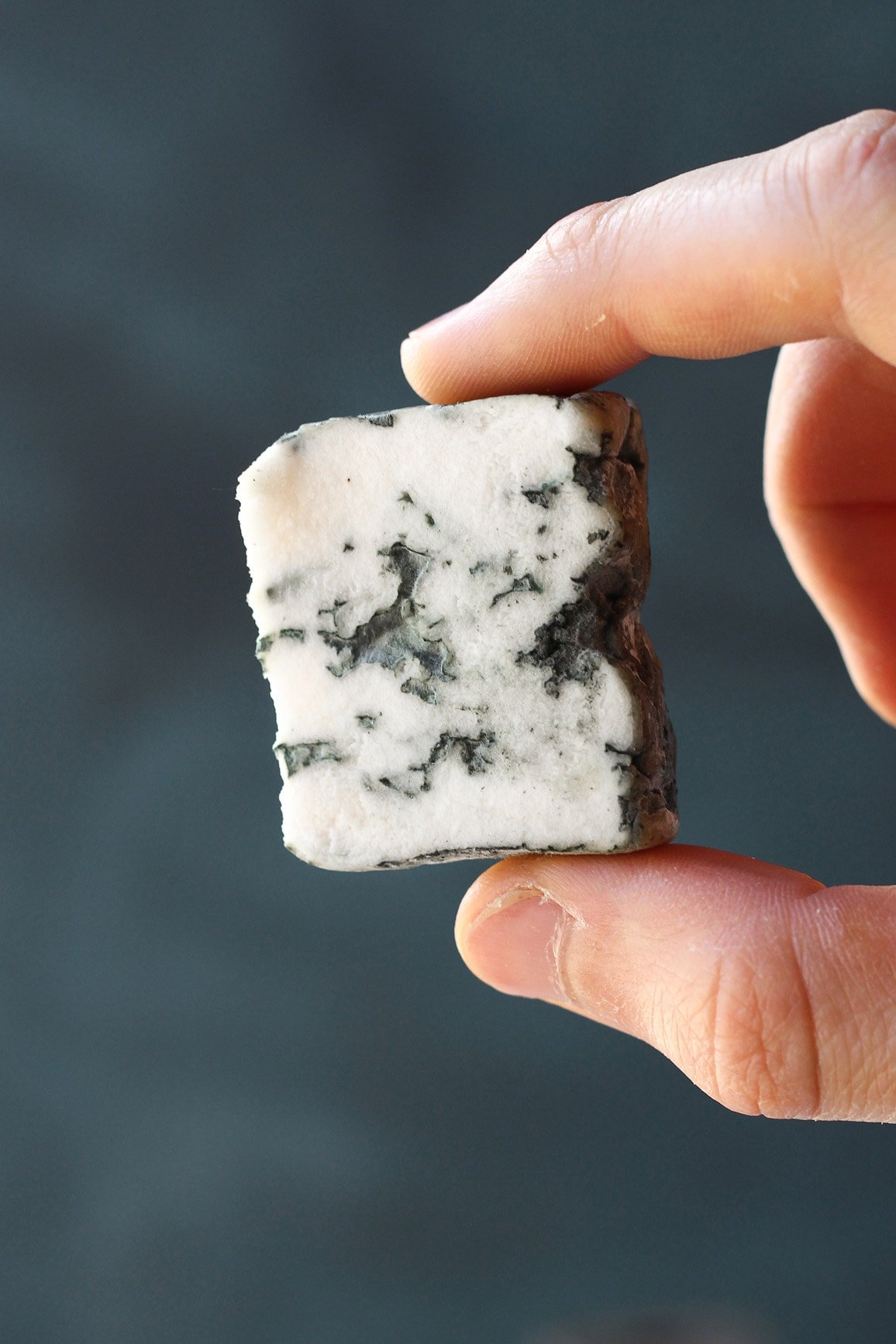
Disclaimer
- The links provided here for Penicillium Roqueforti may not redirect to a fully vegan product as Amazon sellers change product references frequently. Be aware that non-vegan ones are grown on lactose, meaning they contain *traces* of lactose. Considering the amount used, you could still consider your cheese 99,99% vegan. It’s up to you to choose which one fits your beliefs best. One more thing, fully vegan Penicillium roqueforti exists; you will have to do your own research to locate it.
- Many people have been making this cheese without giving any credit back and labeling it as their own. I worked really hard to create this recipe from scratch and had to do a ton of experiments before releasing it, so please give credit by tagging @fullofplants on Instagram or linking to this website.
Final Words
I hope this recipe will prove it’s possible to make everything with plant-based ingredients. If you are not vegan yet, you don’t have to give up on cheese anymore!
Please let me know if you try this recipe, and feel free to ask if you have questions about the process!
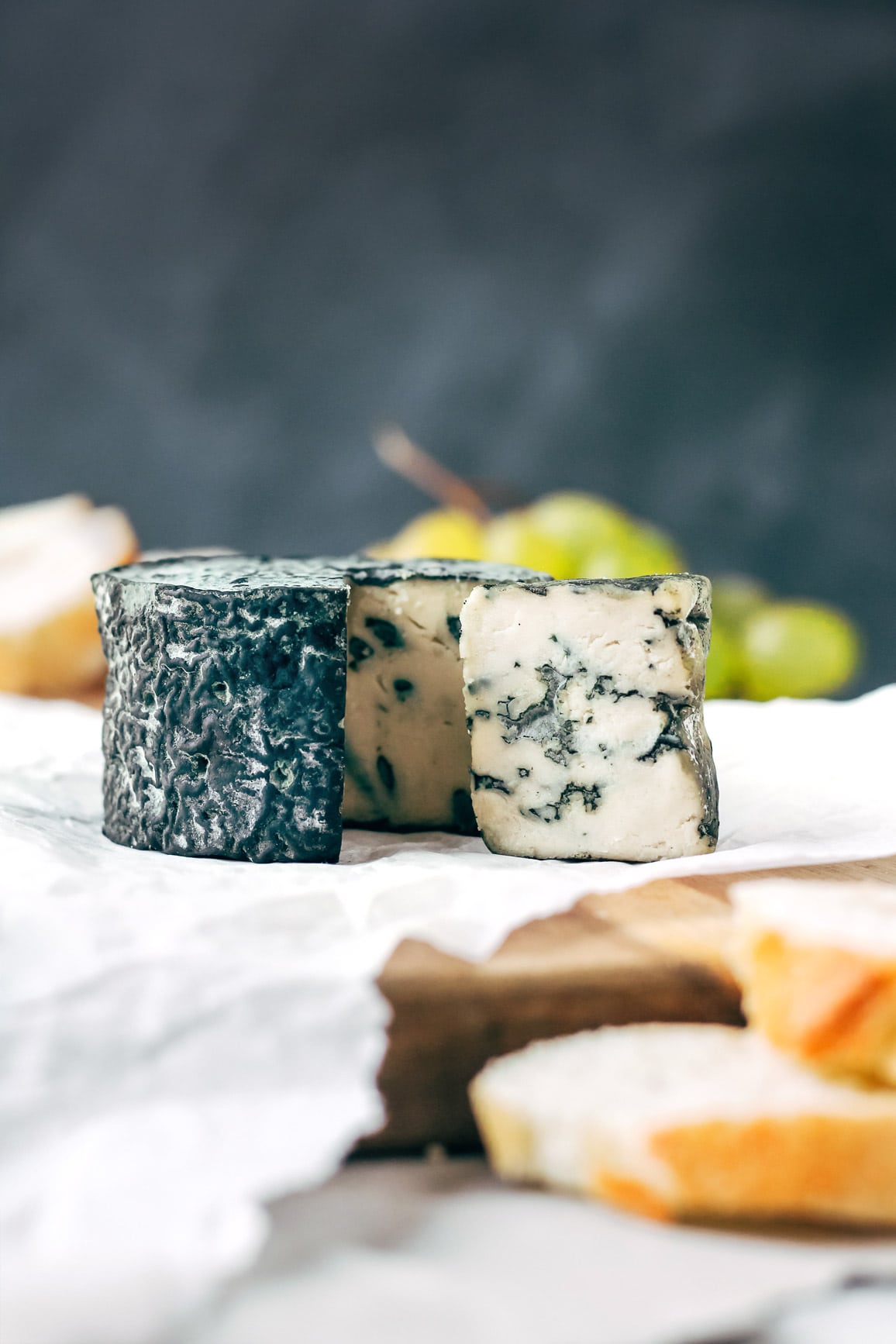
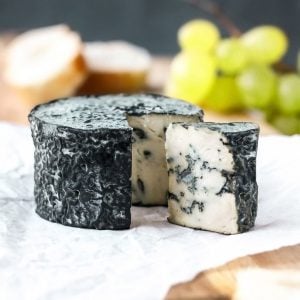
Vegan Blue Cheese
Ingredients
- 3 cups raw cashews
- 2 tbsp refined coconut oil
- 1/8 tsp mesophilic culture or 6 capsules vegan probiotics (Acidophilus)
- 1/8 tsp penicillium roqueforti in powdered or liquid form
- 5 tbsp filtered water
- sea salt
Instructions
The day before
- Soak the cashews in filtered water for at least 5 hours or overnight.
Forming the cheese
- Drain the cashews and place them in a large glass bowl. Bring a large pot of water to a boil. Once boiling, pour the water directly onto the cashews. Let sit 1-2 minutes, and drain the cashews again. This step will help kill possible bacteria.
- Transfer the cashews to the bowl of a blender or food processor. Add the coconut oil and 5 tablespoons of filtered water. Blend on high speed, scraping down the sides from time to time, this step might take about 10 minutes, depending on your blender. You should get a smooth, thick mixture.
- Open the probiotic capsules and add the powder to the blender.
- Add the penicillium roqueforti. If your penicillium roqueforti is in powdered form it works the same way as the liquid one. Blend for another 10-15 seconds.
- The mixture should be smooth but thick. If needed, add 1 tablespoon of water at a time until smooth. Do not add too much water otherwise the mixture will be too liquid, you want a thick consistency.
- Transfer to a clean bowl, cover with plastic film, and let sit at room temperature in a dark place for about 24h. This step is important to let the cheese ferment.
- The following day, place the bowl in the refrigerator for about 4 hours to make the mixture easier to work with.
- After that, line a baking sheet or flat plate with parchment paper. Place 4 small springform pans on top (I used two 3-inch cookie cutter rounds for each cheese, stacked).
- Cut strips of parchment paper and lay them in 4 small springform pans. You want to cover the bottom and sides of the pan. You can also use plastic film if you prefer. The goal is to prevent the cashew mixture from touching the metal. Fill each pan with the cashew mixture and press it down using plastic film, so it doesn't stick to your hands.
- Place a container upside down on the plate where the cheeses sit. This step is essential to keep some humidity inside. It's important for good mold growth. Place the cheeses in your refrigerator (you will age the cheeses covered in your refrigerator during the whole aging process).
Aging
- After 2 days, sprinkle salt over the top of the cheeses, and lightly rub with clean hands. Carefully flip the cheeses using a small plate lined with parchment paper, and remove the springform pan. Sprinkle salt on top and the sides, rubbing gently. You will only salt once. The cheeses will still be very soft, but they will be easier to work with after a few days.
- Flip the cheeses every day, always using clean hands. You can use gloves or work with a plastic film to make sure you are not touching the cheeses.
- Blue mold should start to appear after about 7 days. The mold will be slightly darker or lighter, depending on the humidity and temperature of your fridge.
- After 2 weeks, scramble the cheese into little pieces (just like when you scramble tofu) in a clean bowl. The cashew mixture will still be quite soft, so try to make small pieces. For this step, I highly recommend wearing latex gloves.
- Lay strips of parchment paper into springform pans and fill each pan with the scrambled cheese without pressing too much. This step is important to create holes inside the cheese as the mold needs to be in contact with air to grow. You can remove the cheeses from the springform pans right after shaping them. Place the cheeses on the baking sheet or plate, cover them with a plastic box or container, and place them back in the refrigerator.
- Continue to flip the cheeses every day for the next 3 weeks, always using clean hands or gloves. This step only takes a few seconds every day.
- After a total of 5 weeks, the inside and the outside of your cheeses will be covered with blue mold. They will be ready to eat soon!
- Wrap each cheese in cheese paper or aluminum foil and wait another 3-7 days. The longer you let them age in the refrigerator, the stronger the taste.
- The cheese will keep for about one month in the refrigerator and will become firmer and sharper.
Notes
- Age the cheeses in a container during the complete aging process. Mold needs humidity to grow, that’s why you need to keep the cheeses in a small box or container in your refrigerator. If you were to let the cheeses uncovered, they would dry out before the mold gets a chance to grow.
- Do not omit any ingredient. This recipe is not versatile so I do not recommend substituting or omitting any ingredient.
- Use latex gloves. By using gloves each time you handle the cheeses, you reduce your chances to see bad mold growing. Latex gloves are pretty cheap and come in large boxes so do not hesitate to get yourself a box.
- If you are making vegan camembert at the same time: I recommend you keep them in two separate boxes. Mold can transfer very easily and you could end up with white mold on your blue cheese, or blue mold on your camembert.
- Regarding the appearance of the cheese. The rind of this blue cheese is dark blue because I didn’t scrape the sides. Be aware the rind is edible, but if you prefer the exterior to be white, you can gently scrape the mold using a clean knife every two weeks. I prefer to leave the rind because it looks cooler and after about a month it will become a little bit firmer. Creamy inside + firm rind = perfect cheese to me.
Nutrition

About the Author
Thomas Pagot is the founder, photographer, and recipe developer behind Full of Plants. He created the blog in 2016 as a personal cookbook for vegan recipes. Through years of recipe development, Thomas has successfully grown Full of Plants into a trusted resource for plant-based recipes.
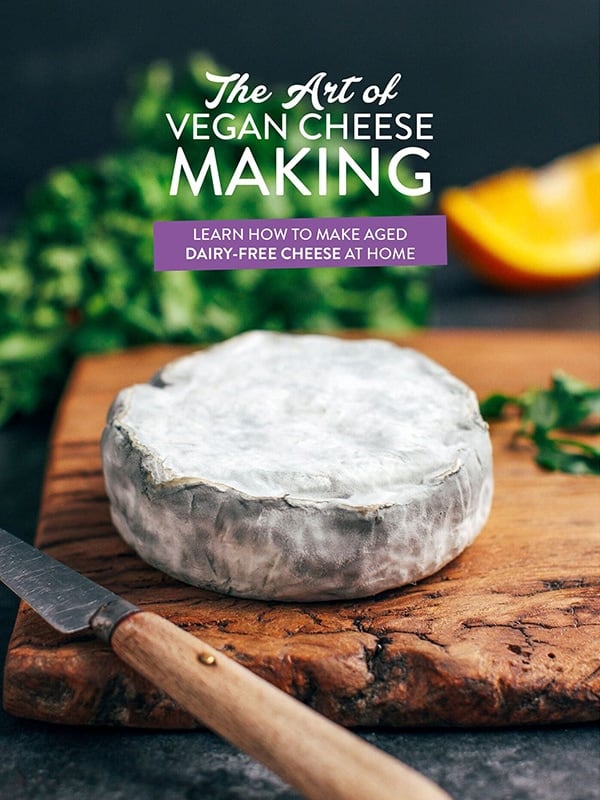
🧀 25 Mind-Blowing Vegan Cheese Recipes!
Sign up for the Full of Plants newsletter and you’ll get new recipes delivered by email weekly, PLUS your FREE 100-page printable eBook!
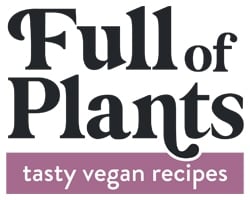
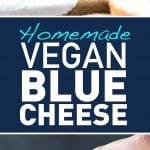
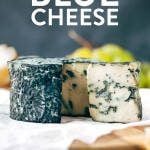
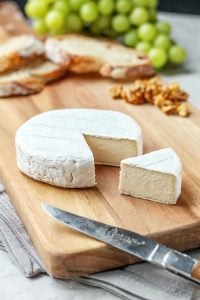
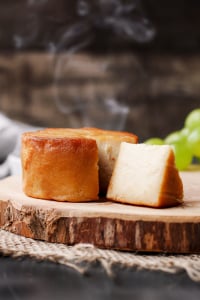
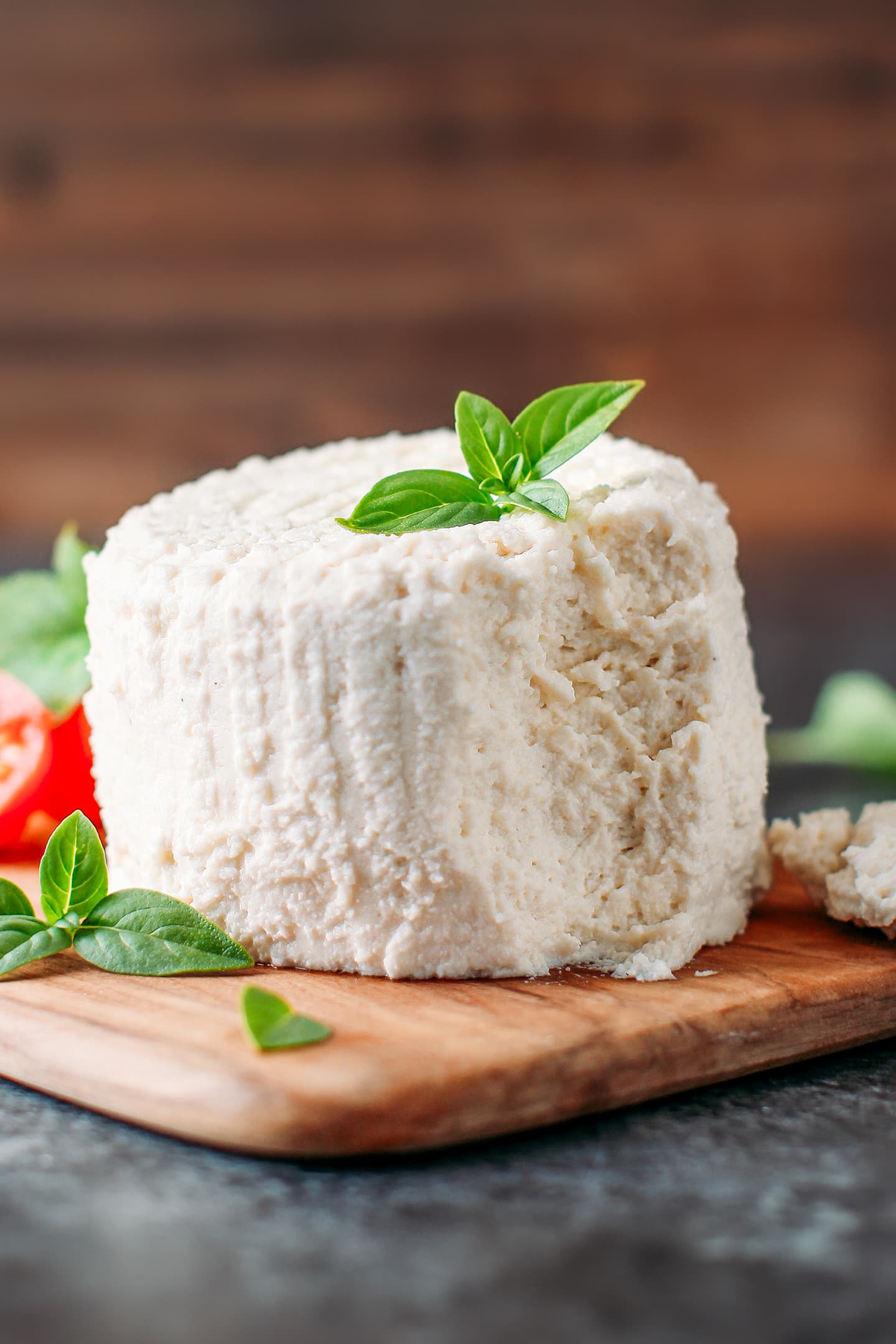
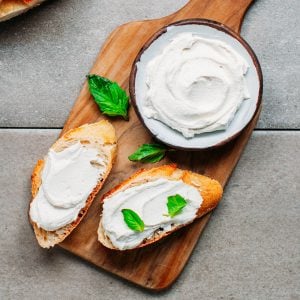
Oh god ! 5 weeks ! This will probably kill me from frustration and impatience but I have to give it a try ! 🙂
Thank you for your amazing vegan cheese recipes … I realise it must have been a lot of work but I hope you know that you make the world a better place ! 😉
Definitely give it a try, it’s worth it 🙂
Thanks for your kind words!
I am in the process of making this cheese and am so excited. I am a bit worried because it did not bubble after being at room temperature over night. My Vitamix gets hot, and I worry that the heat killed the probiotic???
Mine didn’t bubble either. It did seem a bit lighter in texture when I put it in the springform pans though. It was a pretty thick mixture – maybe it’s too hard to make bubbles in something that heavy? Mine is not perfectly smooth, as I was also worried about heating it up too much while blending and scraping. I’m in the “refrigerate in the pans” phase now.
Same here, crossing my fingers!
Exactly, if your cashew cream is really thick you might not always see bubbles. You are on the right track if your cashew cream seemed lighter in texture.
Dara, don’t worry if it didn’t bubble, sometimes it does and sometimes it doesn’t. I’m not sure why, it might be the room temperature, the thickness of the cashew cream, etc, but even if you don’t see bubbles, it will work. My blender gets hot too and I never had a problem with the cultures or probiotics.
Thank so much, I’m having my long awaited blue with a glass of wine and it is amazing!
Hi Thomas,
I made your recipe 2 weeks ago with powdered penicillium. There is no mold forming yet.
What can I do? Can I inoculate the mold on the outside afterwards??
Your pictures seemed so yummie and I’m kinda disappointed
Hi Petrouchka,
I’m sorry to hear the mold didn’t grow, it’s all about the temperature and humidity. Did you keep the cheese in a box/container to keep some moisture inside? At what kind of temperature the cheeses were aging? Sometimes it can take longer to appear, especially if it’s too cold. A few times it took over 2 weeks for the mold to appear on a batch I made, but most of the time it will grow after just 6-7 days.
Inoculating the mold from the outside is more suitable for camemberts where there is a rind, it’s different for blue cheeses since you want the mold to grow inside too. I hope this helps!
happy to hear this as I felt concerned this morning having a look at the mixture in my glass jar.. No bubbles what so ever. But I took advice from the comments posted and I put the mixture in spring forms, but I could fill only two. Have I done something wrong?
Nothing wrong!
is penicillum roquforte vegan ?
Not all brands are, but yes there are some vegan penicillium roqueforti.
I’m having difficulty finding vegan penicillum roquforte. The link in the article above goes to a product on Amazon that has milk in it.
Hi Beth,
Sorry about that! I have to change the link regularly and sometimes they just change the reference…It’s true it’s not easy to find vegan penicillium especially in the US since most of the molds are made in Europe (France). I can’t find a vegan penicillium roqueforti on Amazon for the moment, it seems it’s not always available. This reference is vegan, if you can get your hands on some: PRB 6 HYP 5 D, from Choozit/Danisco. If think it would be possible to make a batch with non-vegan mold and then keep a piece of the cheese to add to a second batch, after a few batches your mold would probably be 99% vegan, but that would take several batches! 🙂 I will keep you updated if I find a website selling a vegan one.
By the way, I also updated the link for the penicillium candidum to a vegan one on Amazon.
Thank you, Thomas. Most of all, thank you for your experimenting and generosity in sharing your cheese making recipes and tips!
Thomas,
After scrambling the cheese and adding back to the spongiform pan, does the cheese remain in the pans for the duration of the cheese making process? Wondering if it’s just until the cheese reforms and then remove the pans. Thanks! So looking forward to this. I’m salting the cheese tonight.
You can remove the pans the following day, it’s just to reform them.
Thanks Thomas, I’m so excited to try this recipe!
Might you use blue cheese from the market to inoculate the cheese you are making?
It’s possible, use about a tbsp of blue cheese instead of the penicillium roqueforti. Of course the final cheese won’t be fully vegan though.
The cheesemaker.com has a vegan tab and sells, among other things, the PRB6 HYP 5D referenced below by Thomas. I just got it (during quarantine). I’m in the process of making my first batch now with it. The vegan penicillin retails for about $45, which I thought seemed expensive. If you consider, however, that it comes in what looks like a 2oz bottle, based on Thomas’s recipe, you’ll have enough for about 96 batches, I.e., less than 50 cents a batch, I.e. a nice big serving of blue cheese every week for the next two years (about the shelf life of the penicillin according to the bottle).
The penicillium roqueforti you mention is kind of overpriced in my opinion. It may be possible to find it cheaper on other websites not labeling it specifically as vegan but still the same.
Hi there, Thomas: Most vegan cheese makers include oil as an ingredient, but I can’t help wonder what purpose it serves, if any, because I make a similar, simpler, oil-free version with great success. What say you? Thanks!L
Hi Damian,
It does add some extra creaminess and richness, but you can omit it. It won’t affect the aging process or the overall flavor.
My cheese has been aging in the fridge for almost 5 weeks now and other covered in blue mold but it’s different than the one in your photo – more ‘fuzzy, kinds velvety. Is it a bad sign? Thank you for the recipe!
It’s quite hard to say, if it’s not powdery and doesn’t smell bad, it should be good.
Hey, I have the same issue. The cheeses are more light blue and velvety. How did this work out for you? Did you end up eating them?
I am in the middle of making this cheese and began August 3, its now Aug 20 and I’m not seeing any blue mould, I am making mine as 1 block shaped in a small loaf pan, its on baking paper on a board with a plastic box covering with several inches space around. My fridge has been running very cold , less than 4C sometimes, today I saw a slight fuzz of white mould , am I okay to continue? Should I be crumbling now even though there is no blue?
4 degrees is way to cold to allow the mold to develop well, that’s why you are not seeing any mold yet.
I don’t seem to be able to send a separate comment, I have just sampled my first batch of blue cheese after 5 agonizing weeks of waiting and while it’s still very mild, it’s delicious! I can’t upload a photo, unfortunately. Thank you thank you, and I look forward to trying the Camembert soon 🙂
Hi Toni,
Thanks for the feedback! I’m really glad to hear you like your blue cheeses! The longer they age, the stronger the flavor!
How long can you age it in the refrigerator for?
I just finished the leaving the cashew mixture out for 24 hour stage.
Thank you for this awesome recipe. Can’t wait to see the results!
You can age the cheeses in your refrigerator during the whole process, it’s actually recommended if you don’t have a cellar or cold room.
can i also use rejuvelac instead of probiotic capsules? since rejuvelac is fermented grains its a probiotic too
Yes you can use rejuvelac, no problem.
Hello, if I use rejuvelac instead of probiotic capsules, do you know how much quantity should be?
Thank you, great recipes!!
Hi,
Yes, just replace the water with rejuvelac.
Hello Thomas,
First of, thank you for the wonderful recipes, I’m in the process of making both the Camembert and blue cheeses for the first time! I was wondering why you recommend keeping them under separate boxes? I have such a tiny fridge (and no room in my apartment that has the required temperature) that keeping them under separate boxes is difficult. Is this essential? Many thanks!
Hi Maria,
Yes it is essential, molds transfer very easily from one cheese to another one, so if you don’t want blue mold on your camembert I recommend keeping them in seperate boxes and always use different gloves when flipping them.
Ok thank you!!!
Hi Thomas,
I started making both cheeses 2 weeks ago- I’m the person that accidentally put the salt inside the mix. The Camembert seems to be coming along really well but it’s it normal that the blue cheese still has no blue mold in it? I scrambled it today and put it back in the springform pans but it’s all white 🙁
Hi Maria,
It all depends on the aging conditions, usually after 2 weeks you should already see some mold growing, but if the temperature is too cold it can take a bit longer.
Hola consulto soy de argentina si saben de donde conseguir el Penicillium. o si alguien lo compra via web. si alguien sabe le agradesco. saludos.
Recomiendo consultar en Internet para tiendas o empresas en Argentina que venden ingredientes para la fabricación de quesos. Se fabrican quesos tipo roquefort y gorgonzola en Argentina, así que debe haber algún lugar que vende las culturas necesarias para hacerlos.
Si no sos integrista en el veganismo, podrías comprar un pedazo pequeno de queso roquefort legítimo y tirar unas partes de las venas azules para mezclar en la receta de tu queso vegano. La cultura es viva, así que debería funcionar. Si eso rinde un queso azul que te guste, guarda una parte del nuevo queso para mezclar en futuras recetas y así en adelante.
Rob, I can read a bit of Spanish and I believe what you have asked or suggested is that if you cannot find the proper bacteria could you use a small portion of a blue cheese to use as a starter with the nuts. That is what I did and the cheese came out fabuloso.
En amazon lo venden.
Hola, Gabriel:
También soy argentino… pero te juro que no es mi culpa, ja, ja…
Hace 30 y tantos años que vivo en Barcelona.
Soy vegano de hace tiempo pero no soy fundamentalista, no kosher no halal… Simplemente soy vegano por una cuestión de salud y criterio alimentario.
El P. roqueforti o el P. camemberti son organismos vivos, de modo que no llevo muy lejos la cuestión de si han estado en contacto con productos animales o no.
Los cultivos que he comprado y que uso seguramente proliferaron en medios animales, pero he entendido que el hongo, puesto en un medio propicio no animal, acabará siendo vegano en esencia ya que si se alimenta de un medio vegetal, los rastros animales quedarán lejos, y cada vez más lejos si retiras venas para hacer nuevos quesos.
No quiero entrar en el debate de si esos hongos estuvieron en contacto con leche o suero en algún momento de su existencia porque me parece que el debate roza la
Idea del Pecado, y evito semejantes exageraciones. Sé que si el queso está hecho de anacardos, mi ingesta será muy, muy mayoritariamente vegetal. No quiero llegar a no pasar la lengua por la franja encolada de un sobre postal porque está hecha con pez…
Disculpa el chascarrillo pero procede. Me parece que rigideces semejantes llegan a distorsionar el puro sentido común. Defiendo mi de isión de ser vegano pero no quiero perder el norte de una sensatez responsable.
Un saludo
Que respuesta más elegante y con sensatez. Felicitaciones!
Por cierto…también vivo en España…compras los hongos en herboristeria o donde? Podrias recomendarme alguna marca q.tenga buena relación calidad/precio ya q.será mi 1a.vez probando hacerlos y no tengo conocimiento del tema para poder elegir una marca en concreto. Gracias!
Thomas, you are heaven sent! I just tried one of my cheeses last night — and two of us finished it. The texture was perfect. The flavor was a delight. I’ve missed blue cheese. And now I don’t need to miss it anymore. It was so delicious. I have three left. I am saving one to be my starter for the next batch. You may or may not recall that I used a piece of roquefort cheese as my starter with the idea that I am going to do 3-4 successive batches and hopefully “clear out” all the dairy. We are thrilled. I want to share it, but I want to keep it. Anyway, today is five weeks and two days. I can’t imagine how three months will taste. I will start another batch this weekend. And I will attempt the camembert in the same way — with a piece of camembert starter. Patience is worth it!
I’m SO glad to hear you loved your blue cheese Kathy 🙂
I agree, it takes so long to age and then it’s gone in no time 😉 Good luck with your camembert!
Thank you ever so much for the time, expense and determination this evidentally took to perfect these recipes. I cannot begin to appreciate the detailed scientific labeling and logging of information this has require to make it be successfully reproducable. Again, my hats off to you!!!
Thomas, what is your background and what motivated you to do this? Have you looked into into providing widespread manufacturing and distribution of the end products? You shoul please!
Technical question: I have an Excalibur 9 drawer covered door dehydrator with adjustable heat setting from raw and ambiant air temperature 95° / 35°c –all the way up 155°f/68°c. I could use for controlled fermentation/storage while proofing. Have you any information on this being helpful in this processing?
I love that you are a food scientist and would be interested in discussing other of your projects. Please contact me. Mo
You’re welcome! Thanks for the kind words.
I’m not interested in producing and/or distributing vegan cheeses, I just like to make them as a hobby and share the recipes with everyone.
Regarding the dehydrator, I never tried but since the culture is a mesophilic type, it doesn’t require too warm temperatures to work. It’s always working for me at room temperature (taking 24-48H), but if you want to speed up a bit the fermentation I would recommend to let ferment the cashew cream for 8-10 hours at 35°C. If using thermophilic cultures, then the temperature will have to be slightly higher, around 55°C.
I am truly thankful for you!
I just became vegan and it’s because of awesome replacements that it works for me. Cheese was a deal breaker until I tasted vegan nut cheese. I thought I’d never be able to have blue cheese again but I’m stoked. I started mine tonight! Thank you for your talents and time !
You’re welcome Debra 😉
My blue cheese is about three weeks old. It has beautiful lovely blue mold all over it. I scrambled it a few days ago. I tasted it and it doesn’t taste much different.
Or optimum ripeness ( I like it stinky). How much longer should I age it? I’m patient.
This is normal, you should age your cheeses for at least 5 weeks, and even more (2-3 additional weeks) if you want a strong blue cheese.
It looks like none of the penicillin is vegan. Do you have a source that is, or do I need to just keep looking?
That is not true. Please keep looking and you will find a vegan version. If you are living in Europe, check out Cashewbert, they have certified vegan cultures 🙂
Hello, I have made the blue cheese, following your recipe. I am about one week away from the end of the whole ageing process, and I can see an orange colour forming. Of the six I’ve made they are all different in ‘blueness’, too. The ones with an orange tint smell a little strange. Does this mean they have gone the wrong way, or is there hope of them being ok with more air or scraping, or anything?! I hate to think I’ve lost a whole batch…!! They are in plastic Tupperware boxes, two in each box, lined with parchment. In the fridge. Thank you Xx
Hi Kirsty,
Orange mold is not good, especially if they smell “strange”. I would recommend trashing them and starting over.
If some of them have no orange mold, then separate them from the “contaminated” ones and wrap them in cheese paper.
Next time, try pouring boiling water on the cashews and let it sit for 1 minute. This should kill some bad bacterias. Also, use gloves when handling the cheeses if possible.
Oh you wonderful person! I have been so waitiNg for This!
You’re welcome Beryl!
Can’t wait to try this! Thank you!
I wanted to ask you if you think that aging it less would achieve a result more similar to the italian Gorgonzola Dolce. I am italian and tbat is my favourite kind. It is much milder, softer, smoother, almost liquidy at room temperature.
Thank you again for helping the cheeae loving vegans
Cinziar
The saturated fats give it more texture and robustness. Maybe add less of the coconut oil if you want it to be “almost liquid” as you say. And yes leave it shorter for less flavor.
Just a tip, I haven’t tried it myself but that is what I would do.
Hi Thomas, thanks so much for this recipe, I will be starting mine tomorrow once I get all the stuff. Could you please tell the temperature the fridge should be at? I have mine on 2C.
Saw the picture on foodgawker, thought “Looks like something Thomas could have made.”, looked at the source name, oh hey, it’s Thomas :’D
You’re the best! Maybe one day you’ll invent a vegan Taleggio! (hint hint) ^^
Thanks Anja!
I will have to take a look at that cheese 🙂 My next one will probably be a washed rind cheese.
The news just gets better and better!
Well, then you’re on the best way to a Taleggio, that IS a washed rind cheese 😀
Gosh, I’m so hyped! I hope my penicillium will arrive soon so I can finally start my first Camembert!
oh my gosh this is the most incredible thing i’ve ever seen. you should go into business!!!
I prefer to share the recipes so everyone can make them at home 😉
That’s the right spirit. Keep on! And Thank you
They are alot of work to make so while I love having the recipes if you made them ready to go I would purchase.
Hi Thomas
The penicillium roqueforti is manufactured by DuPont, which is a huge chemical company. Are there products organic and plant based? Is there a way to check?
I’m used to making raw vegan cheeses but with more natural ferments like rejuvelac, kefir etc… so i’m a bit concerned with the quality of the ferment.
Thank you!
Hi Karen,
I’m not sure about that, I don’t think it’s possible to find penicillium roqueforti labelled as organic for the moment (but if you find something, let me know!).
The one I’m linking to is the exact same product and brand I bought from another website that labelled it as vegan, so this mold is vegan.
Penicillium roqueforti used to grow on rye bread in caves, but I’m not sure how it’s made today.
By the way, you can replace the water and probiotics with rejuvelac, it will work.
Hello Thomas O great one!
I love your work! I want to try this recipe, but it was a broken link for the Penicillium roqueforti. Do you have the link from where you ordered that was vegan?
Hi Olof,
Thanks! The link should work now.
GREAT! Many thanks superstar.
Hi Thomas! If I use rejuvelac and replace the water and probiotics, how much rejuvelac should I use?
Hi Coco,
3-4 tablespoons of rejuvelac should work. Use the rejuvelac in place of the water.
Isn’t rye bread mold what is believed to have caused all the “witch” trouble in Salem, Massachusetts? If I remember correctly I believe the article I read many years ago said it was how LSD is made! LOL Just thought I’d throw this out there, I do want to give your recipe a try, I’ll take my chances with the mold but if I get arrested for dancing naked under a full moon I’ll be directing the police to you!!!
I have never heard of this story, sorry! So I can’t give you an advice on how to make LSD from blue cheese 🙂 But I know that penicillium roqueforti is safe.
There are very many different types of fungus. You’re thinking of ergot, Claviceps purpurea, a disease of rye plants. That’s a totally different species than this.
Holly guacamole!!! This just blew my socks off! Looks awesome!! I love your cheese recipes, must get some of the ingredients and give it a go! Yummo.
Congratulations Thomas! This is such an achievement! It looks fantastic, It is the first vegan blue cheese I ever saw. Will definitely give it a try! Thank you so much for sharing!!!
After making your fabulous Camembert I can’t wait to try this one. Thank you so much – you are a star.
I add my delight and thanks like all the people who have commented above, Thomas! I knew you were working on this process, and so I ordered my penicillium roquefort in hopes it was coming, I’m SO excited to give it a try! You are really great to share all these recipes, you are brining something new and wonderful to vegans. Thank you!
Hi Thomas, how much of the penicillium drops do we need to add? In the recipe, it just says to add it. Thank you so much!
Hi Monique, I’m not sure about drops but I would say 6-8 drops. As much as needed to fill 1/8 tsp as written in the ingredients.
The data sheet I received along with the Penicillium Roqueforti says you can store it 12 months at -16C (3F) and 2 months at 4C (39F). Do you think repeated freeze/thaw cycles would hurt the culture’s viability? I might repackage mine into smaller quantities before freezing so I can use it a little at a time.
I am so looking forward to this as soon as my mini springform pans get here. Scrambling the cheese to aerate is such a great idea!
I have been using the same penicillium for over 5 batches. I let it defrost in the fridge, use what I need and put it back into the freezer, I never had any problems!
This recipe is genius! I have to try it (and the camembert!). I just have to find the penicilium in France, but we are suposed to be the cheese country, so >I hope i’ll find it easily!
Can you tell me if you succed in this search? ^^’ I’m frensh too and looking for Penicilium..
Thanks!
Do you think this would work with a different nut, maybe macadamias or almonds?
Yes, I think it can work with other nuts. If using almonds, make sure the skin is removed. The texture might be a little bit different though, cashews are really soft and blend while almonds are harder. Macadamia nuts are more expensive but would probably be the best alternative.
Hey Thomas, thank you so much for sharing this recipe. I have just made the cheese today, one version with acidophilus, the other one with rejuvelac. I am curious to check the difference in taste, since I’d rather use rejuvelac (much cheaper than commercial probiotic). Can’t wait for the results! 🙂 Cheers!
Hey Pedro! Awesome, let me know the results! Yes rejuvelac is cheaper but it’s also more work 🙂
Hi! I just ordered the penicilium candidum for the vegan camembert and I’m really excited! I am definitely interested in trying out the bleu cheese once the camembert experiment is complete. Good cheese is one of the most difficult things I’ve given up- way harder than meat 🙂 Are you working on any more types of cheeses? I’m so impressed with and grateful for the work you’ve put into these recipes!
Hi Cheryl! Thanks for your kind words! I felt the same, cheese was the hardest to give up! I hope you will like the vegan camembert! Blue cheese takes longer to age but it is also stronger in taste 😉
Yes, I plan to work on washed rind cheeses really soon (as soon as I get a refill in cashews!) and several other recipes that uses vegan cheese.
Stunningly looking cheese. I have just ordered the penicillium roqueforti culture. The supplier is wholesale, so I was forced to take the amount of it enough for 500 liters of milk! Anyway, the price was 32 euros, so isn’t so painful. I am not totally vegan, but do not consume meat and I am allergic to dairy protein, so have to look for other options. Hope, this cheese turns out good. Thank you for sharing the recipe!
Thanks Vytautas! You can store the penicillium in your freezer and it will keep for a loooong time so you will be able to make a lot of cheeses in the future 😉 Feel free to keep me updated!
Hello Thomas,
I am very excited to make this for my vegan husband, and perhaps with your cheeses I can move on from vegan-in-training as well. The penicillium roqueforti that your link led to is out of stock indefinitely, and in looking around I see there are several choices. Are they all the same, or is there anything I should know about which to kind choose? Thank you…
Hi Julie, I guess many people bought it to make some vegan blue cheese 🙂
Yes there are other choices, some in powdered form, others in liquid form, both work.
There are many different molds, some are slightly stronger than others but I always used the same bottle so I can’t give you much information about the differences.
I would recommend this one: https://www.amazon.com/Penicillium-Roqueforti-Doses-Bluish-Green-Veins/dp/B017OS8PRA/ref=sr_1_4_a_it?ie=UTF8&qid=1473448508&sr=8-4&keywords=penicillium+roqueforti
or this one (PRB6 liquid option): http://www.cheeseconnection.net/product/penicillium-roqueforti/
I hope this helps!
Can penicillium roqueforti be used in cow milk or just with nuts
Thomas, is the temperature for ageing the blue cheese the same as for the camember?
I recommend aging the blue cheese in your fridge, in a box to keep some humidity. This way they will be more creamier than if you age them at a higher temperature.
i don’t have a box per se i am covering it lightly with plastic wrap. i don’t see a lot happening after almost a week did i ruin it? what kind of box do you use can you post a pic of it?
thanks
wendy
Do you have a tupperware box/container or something similar? I would not recommend covering the cheeses with plastic wrap, they need to be in contact with the air. I don’t think they are “ruined” yet, wait at least another 7 days (with the cheeses in a container, with no plastic film touching them), depending on the temperature of your refrigerator the mold can take longer to appear. Good luck!
ahh i do not have a tupperware that will fit all three cheese in a 4″ mold, but i can do that now since i still have to squish them in a few days.
thank you for your advise. i will try to buy something that will fit in the fridge and fit on the cheeses. my plastic wrap is loose tho..
xox
wendy
Hi, Thomas.
Does it matter what kind of salt I use? I know that cheesemakers use only non-iodized salt. They say, iodine has a destructive effect on cultures. Thank you.
Hi Vytautas,
I don’t think the kind of salt you use really matters that much. I used table salt and had no problem at all! Sea salt works too.
Thank you! I will start my “first batch” when I receive the mold culture.
By the way, excellent photos. I myself am a photographer, so have to say – you have a good taste as a photographer also!
You should be selling this there is a big market for these vegan dishes.
Thanks Brian 🙂
How exciting! I can’t wait to give this a try, but probably not until the new year as I won’t be in one place for long enough until then. Thanks for the recipe!
Hello Thomas,
I am amazed by your recipes, thank you so much for making them! Just ordered what I need to make Camembert but I will also try the Goat Cheese! 🙂
I have heard it is possible to use the same mold cultures you used here (Penicillium Roqueforti) to make Gorgonzola.
Have you ever thought about trying something like this or have you even tried it already? I thought maybe you had an idea how to do it?
I suppose I would just let it sit without scrambling it and maybe removing excess mold?
Hey Pauline,
Thanks!
I never tried Gorgonzola, and I’m not going to now 🙂 but from what I read, Gorgonzola is a kind of blue cheese. What makes it special is that it’s made in a specific area of Italy.
If you don’t scramble the cheese, or pierce it, you won’t get the blue veins inside. You can definitely scrap the sides if you want the exterior to be white.
My little cheeses are on day 6, and I see a faint blue tint. It’s very exciting! I’ve been flipping them by putting a little piece of parchment on top, flipping it onto that, then leaving the parchment under it until the next night’s flip. That seems to work really well.
Awesome! Keep on flipping!
I’ve gone almost 10 days and no sign of mufa! What am I doing wrong??? It smells like blue chees there’s just no blue!
Wait a bit longer, sometimes it can take up to 20 days before blue mold appears, it really depends on the aging conditions.
Ugh! I just scramblednit up in hopes that it might mold. But holy Hannah! It tastes just like blue cheese! You’re a god!
Thanks Thomas for sharing this recipe and the camembert!! I ordered the pencillium and can’t wait!
I will use rejuvelac instead of the probiotic capsule. should still be nice?
You’re welcome! Yes rejuvelac will work well!
Hi Thomas,
I’m trying out this recipe for the first time and would like to ask a quick question.
When you get to the stage of taking the cheeses out the moulds after two days and salt them daily do you then keep them in the fridge back under the plastic box or leave the box off?
So excited of the possibility of vegan blue cheese. looking forward to seeing if this works for me
Thanks
Sorry to be a pain but I have another question. I’m on the 2nd day of the salting process and noticed the cheeses are sitting in a puddle of water (due to the salt I assume) and the cheeses themselves are very wet. Is this ok? I did put the plastic box back over them in the end and they are sitting on greaseproof paper, maybe I should sit them on kitchen towel to soak up the water?.
You only salt them once right? If you have too much water in your box, yes use a clean paper or kitchen towel to soak up the water.
Hi Adriana,
Be careful, you don’t salt them daily! You salt them once and then flip them daily. Yes I keep the cheeses in the fridge at all times, in the plastic box.
Doh! I misread and though you had to salt them every day for 2 weeks (thought that’d make them rather salty). Phew thank goodness I asked. Thanks so much for getting back to me.
I just realized this too. I thought the salting was part of the flipping. It’s almostbeen 2 weeks! Have to start over. 🙁
Me too! I salted for 3 days! Do you think the mold will still grow thomas?
I have another question…
Do you mean we would need to keep them inside a box or we need to put them on a rack and cover them with a plastic box?
I’ve had the camembert on a rack covered with a box and nothing has happened (probably because of the temperature and 2 days of salting). About the blue cheese, I have it on a rack but without a cover and there is no blue on it either and it is dried on the outside 🙁 Do you think the mold will still grow besides the edge being dried???
Thanks so much!
Thank you so much for generously sharing your recipe and process!! I am wondering if either the
Camembert or this Blue cheese can be made with different nuts. I’m thinking blanched ‘hazelnuts’ just because they grow in our area. Or even pine nuts. I also have a bit of a sensitivity to cashews. I know hazels are strong-tasting, but perhaps pine nuts can work…I would love your thoughts.
Take care,
Melissa
Hey Melissa,
I always made the cheeses with cashew nuts because I bought a huge bag of raw cashews 🙂 I think it would work with hazelnuts, but the taste would not be as good since, as you said they have a strong taste, even blanched and raw. Pine nuts would work better, their taste is very subtle and they are pretty soft so they would blend well. It would be a lot more expensive to use pine nuts though.
I hope this helps!
Thanks so much Thomas. We grow a few pine nutes here (as well as hazels), and hope to find excellent recipes for the things we can grow in our northern climate! This is just fantastic research that you’re doing. One question I have, and I don’t know if you’ve explored this: is it possible to make a very rich nut cream, and then culture that (thus straining out the fier)? vs using the whole nut in the mix? I’m trying for that soft, liquid effect, but have no idea if it could work this way. Thanks again! Melissa
Hi Melissa, you’re welcome. Glad to hear you can have cheap pine nuts! Otherwise it would cost an arm to make cheeses with store-bought ones 🙂
I never tried to strain out the “fiber” of the nuts, and I’m not even sure if it’s possible since the nut cream is already very smooth. If you remove the solids from the nuts, I guess you will be left with something that is very liquid, and it will probably never firm up. If you are trying to make a very creamy cheese, you could add a few tablespoons of refined coconut oil, but in my opinion the cheeses are already pretty soft and creamy.
Thanks so much for you’re reply, Thomas.
Melissa
I want to try this recipe, but do you think I could add some ingredients. Say maybe nutritional yeast? Or do you think other ingredients would interfere with the probiotics?
You can add nutritional yeast if you want, but honestly there is no need for it.
Hello Thomas!!!
You arejust amazing. I would love to see you experimenting. You have so far my best vegan cooking blog !!! I already taste your vegan camembertrecipeand the flavour is great but i can´t really get the rind you make in yours.
Here in Berlin i can´t find the penicillium in drops and by mixing 1/8 of tsp of penicillium powder in 10 tablespoon of water i can just make 8 cheeses and not really getting the rind. Am I doing something wrong right?
Thanks so much for your patient!!
Fanny
Hi Fanny, thanks!
Are you aging the cheese at the right temperature? When did you start your cheeses? The rind takes some time to appear.
Powdered penicillium should work as well as liquid one, but feel free to check out this website, they have liquid penicillium: http://www.oberacker.de/product_info.php?cPath=37_47&products_id=2743&language=en&osCsid=8ng5agamquu9vlnje5ja1mdie3
If you don’t have the rind you are missing a lot, the flavor is totally different. Let me know how it goes.
Hi, Thomas!
Finally, I received the penicillium roqueforti culture. I was shocked to find out it is an amount meant for 10000 liters of milk! Now it is in the freezer. But I still wait for my ordered springforms to arrive, so cannot start the cheese as yet.
By the way, have you given a thought of trying to make Feta cheese? I used to love it when many years ago. Or do you think it is hardly possible to achieve its taste with nuts?
Where were you able to purchase/order the penicillium roqueforti culture? I haven’t been able to find any online that are vegan. Thanks in advance for your help! 🙂
Well, it is a company (Baltvita) in my native country Lithuania. You can google for it. But I do not think it supplies to other countries, though.
I live in New Zealand and was able to purchase vegan culture from Australia https://www.cheesemaking.com.au/product-category/vegan-cultures/
Your recipe looks awesome! The link you provided for the penicillium roqueforti no longer exists. Do you know of any other vegan sources for the product? I’ve tried looking around and I’ve only found ones with dairy included in the allergens list. Thanks in advance for your help!
Hi there, firstly thank you for such a lovely blog, your photography skills are amazing. Like a lot of people I struggle with cheese and so have made my own dairy cheeses in the past so was so excited to find this recipe. I actually have a microbiology background so very interested to learn more about nut / soy cheeses and how their macro’s interact with traditional cheesemaking elements. You may want to include some other cheesemaking elements too – I’m experimenting with lipase at the moment which is definitely adding to the complexity. Im keen to learn more about the salt ratios required to favour only lactobacillus – better for food safety.
One question – did you blue ever look fuzzy like a tennis ball? You didn’t show any pictures of that but mine had a big blue bloom until I broke it up and waxed it.
Cheer!
Mel
Hi Melanie,
Thanks for the kind words 🙂
I never heard of lipase, sorry.
Yes the blue (and it’s the same for the camembert actually) looks fuzzy at first, but since you flip them everyday, the rind becomes flatter and after a few weeks you don’t see the “hair” effect. As long as the mold growing is blue/green you are on the right track, just leave them.
my Blue cheese mold is growing white….like Camembert one…is that OK?
Some white mold can grow as well, it’s okay as long as it’s not fuzzy white mold.